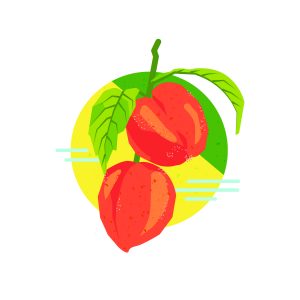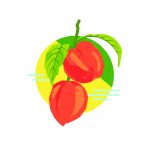
The peach (Prunus persica) is a deciduous tree indigenous to the Northwest region of China between the northern slopes of Kunlun Shan mountains and the Tarim Basin where the peach was not only first cultivated but also domesticated. The peach plant bears an edible succulent fruit known as the peach or a nectarine. Peaches and nectarines might be the same species, but they are commercially considered to be different fruit. Genetically, nectarines are produced from a recessive allele for fuzzy skin whereas peaches are produced due to a dominant allele for fuzzes on the skin, hence the difference.
The world’s largest peach producer is China, followed by Spain, Italy, Greece, and the United States.
Chinese mythology tells of a group of deities celebrating the everlasting life provided by the fruit every six thousand years, in an extravagant ceremony called the Feast of Peaches. The legend, usually referred to as the Peaches of Immortality, explains that the peach trees planted for the occasion would take 1,000 years to sprout leaves, and another 3,000 for the peaches it produced to ripen – talk about delayed gratification!
Even today, the feast remains a popular celebration in China, observed annually on the third day of the third moon month. And all across Asia, the peach is still associated with, if not immortality, then at least vitality, thanks to the beautiful blossoms that appear on their trees before their leaves even start to sprout.
Agriculture Facts:
- The life of a peach tree is about 15 years, and peaches don’t bear fruit during the first two years.
The trees produce some fruit the third year but bear the most peaches in years 4 to 15. - Georgia grows 130 million pounds of peaches each year, but California and South Carolina produce even more.
- The United States grows 978,260 tons of peaches each year. That’s 1.9 billion pounds!
Nutrition and Food Facts:
- Peaches are packed with several major nutrients, including vitamin A (beta-carotene), vitamin C and potassium.
- One medium-sized peach contains just 38 calories.
- Peaches are an excellent source of fiber, good for blood sugar and naturally fat free.
History and Lore:
- Both in China and Japan the peach is associated with immortality and a long life.
- It is one of the “Three Blessed Fruits” in Buddhism and symbolizes longevity.
- The peach blossom is a symbol of spring in Korea.
- The peach originated in China and has been cultivated at least since 1000 B.C.E.
- Peaches traveled west via the silk roads to Persia, earning them the botanical name Prunus persica. In Persia, peaches were discovered by Alexander the Great, who mentions half a dozen types, and who introduced them to the Greeks.
- The Romans called the peach a Persian apple, and the name for peach in numerous languages is the name for Persia.
Spread the word and build partnerships
Don’t be a solo act. Invite your community to the table!
Promote in-house:
- Announcements
- Newsletters
- Website
- Social media
- Events (health fairs, open houses, garden working events, back to school, holiday activities, parents night, sporting events)
- Meetings (PTO, wellness committee, board of directors, staff professional learning days)
- Food tastings during events
Promote in your community:
- Report on activities and share pictures with news sources
- Share with community partners for their websites, social media and newsletters
- Post fliers at public places (libraries, health centers, non-profit hospitals, garden groups, local farm hubs, farmers markets, health agencies)
- Ask students to create and publicize local food stories – include photos or create videos
Invite others onsite to get involved:
- Build impact by engaging culinary arts, Future Farmers of America, wellness, botany, ecocentric and garden programs
- Create relationships and engage non-profit hospitals, garden groups, local farm hubs, farmers markets, health agencies and advocates
- Find support in local culinary leaders and businesses
Celebration Tips
August 22 is the National Eat a Peach Day in the United States. This date was chosen because peaches are harvested between June and August.
Why not host a Peach Festival Day during late summer feeding and celebrate local peaches with your kids. Need ideas, or printable activity sheets? Click on HMC Farms Produce Mom Corner for free downloadable activity sheets and ideas.
Curricular Connections and Activities
K-12:
- How Does It Grow? PBS Kids: Peaches
- USDA Peach Tree Orchard
- Pick a Better Snack- grades 2-3
Menu Icons


Recipes
We have many recipes for you to look through in our Recipe Index! Here you can see take-home recipes for use in the community as well as more choices for your cafeteria. We have hot and cold recipes for most foods. Be sure to use the provided icons on your menu!
- Peach Food Service Feature Recipe: Fresh Peach BBQ Sauce
- Peach Home Featured Recipe: Peach Pie Pops Recipe
- Peach CACFP Recipe: Fresh Peach Muffins
